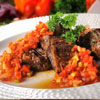Pastry
Pastry: In bowl, mix flour with salt. Using pastry blender or 2 knives, cut in butter until mixture is in fine crumbs with a few larger pieces. In a liquid measuring cup, beat egg yolk with lemon juice or vinegar; mix in enough ice water to make 1/3 cup of liquid. Drizzle this liquid over dry ingredients, stirring briskly with fork until ragged dough forms. Press into a ball and wrap in plastic wrap and refrigerate until chilled, about 30 minutes. Note: you can make this pastry ahead and refrigerate it—covered well—for 2 days. On a lightly floured surface, roll out pastry to 1/8 inch thickness; fit into 9-inch pie plate. Trim edge to ¾ inch overhang; fold overhang under and flute edge. Prick shell all over. Line with foil; fill with pie weights or dried beans. Bake in bottom third of the oven at 400 F for 15 minutes. Remove weights and foil; bake until evenly golden, 10 minutes longer. Let cool on rack.
Cut off Swiss chard stems; discard or save for another use. In a pot of boiling salted water, cook Swiss chard leaves until tender, about 2 minutes. Drain and chill in cold water; drain again and squeeze dry. Chop leaves; set aside. In a skillet, melt butter over medium heat; fry green onions until softened, about 3 minutes. Stir in Swiss chard, parsley, salt and pepper. Set aside. In separate bowl, beat together eggs, ricotta cheese and cream until smooth; stir in Swiss chard mixture and half of the feta cheese. Pour into pie shell; sprinkle with remaining feta. Bake tart in centre of oven at 375 F until filling is set and golden, about 35 minutes. Let cool on rack for 10 minutes before cutting into wedges. You can make this tart ahead of time and let it stand for about 4 hours. You can also cover it well and refrigerate it for up to 24 hours. Before serving, let it come to room temperature. Makes 6-8 servings.



